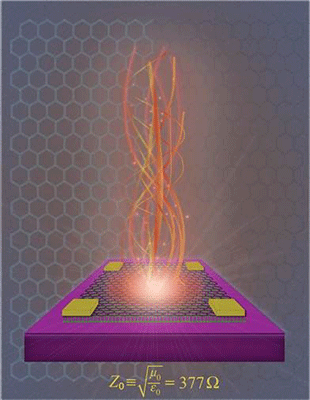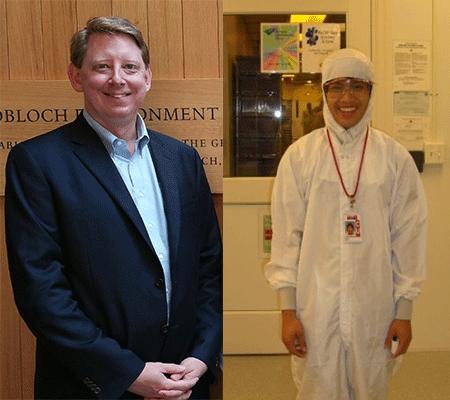UCI Researchers Change Transparent Material into a Mirror with Electricity
Far-infrared (THz) light can pass through graphene or be reflected, and this can be tuned using electricity in real time.
This is a simplified explanation of what Samueli School researchers accomplished recently using a single layer of graphene, a one-atom-thick, transparent and flexible material. In a paper published recently in Nature Communications, electrical engineering and computer science Professor Peter Burke and his graduate student Phi Pham showed that critical transition points in the graphene’s properties – from a reflector of light to a transparent material – can be activated by applying this DC voltage, also called gate voltage.
Previously, researchers believed that a material’s property – whether it was transparent, reflective or absorbing of electromagnetic waves – was based on its geometric structure. Pham, Burke and their collaborators showed that this property can be changed using voltage.
Burke explains that certain materials – indium tin oxide, for example – can have different conductive properties based on the thickness of the material when it is deposited on another material. “It can be reflective, like a mirror, or absorptive or be a transmitter,” he says. “But once you deposit that material, its electrical properties are fixed forever.”
By contrast, graphene, which is a conductor in its natural state, can be “tuned” to a different state, simply by applying the voltage. “We’ve created this transition point, where the material isn’t a metal and it isn’t an insulator,” Burke says. “And the material is only one atom thin, so that’s the ‘wow’ factor.”
The light used in these experiments is not visible light; it is terahertz-wave light, which means it is close to far-infrared light on the electromagnetic scale. Terahertz waves are smaller and higher frequency than millimeter waves, and larger but lower frequency than visible light. Burke (left) and Pham collaborated with researchers from Wright State University.
Because the ability of the waves to provide high-resolution images increases as their wavelength decreases, this tuning breakthrough could have applications in a number of areas: millimeter wave and terahertz components and systems, including wireless communications; security cameras that could see through walls in ultrahigh resolution; and possibly even anti-reflection coatings on aircraft for stealth purposes. “You could potentially make a plane disappear from radar and then reappear,” Burke says.
A lot of work was required in the UCI cleanroom to make this tunable material. First, Pham had to grow the graphene in the lab, one crystal at a time, by applying heat to a single carbon atom seed. And, because of the nature of the experiment and the millimeter size of the light beam, he needed to make large pieces of atomically perfect, single-crystal graphene – at least one millimeter square. Pham grew the graphene on copper foil and then transferred it to glass, making sure it stayed clean at all times because any dirt could turn it into an insulator.
He first did a coarse tune by adjusting conditions as the graphene grew, moving the material closer to the boundary between reflector and transmitter. Then he used the DC voltage to fine tune in and out of the two regions. “He probably did around 1,000 growth runs in the cleanroom to get the material’s properties tuned right,” Burke says.
“We’ve made this transition point in the material where we can tune it just by turning a voltage,” he summarized. “As far as I know, this has not been done with any other material.”
Pham, Burke and their UCI partners collaborated on the paper with researchers Elliott Brown and Weidong Zhang from Wright State University in Dayton, Ohio; the latter were responsible for precise THz measurements and analysis.
The work was supported by a U.S. Army Multidisciplinary University Research Initiative (MURI).
- Anna Lynn Spitzer
